The beliefs — test-based accountability, financial flexibility, and “choice” — the principles — the pillars upon which No Child Left Behind (NCLB) promised “to close the achievement gap” — have FAILED.
The theory was hailed by state education officialdom prior to NCLB. So all-in-all this grand experiment, concocted by those unwilling to listen to people in the trenches, had decades to “work” to “close the achievement gap.” It failed; it’s a FACT!
People across America are waking up to the reality that testing itself is wasting instructional time and our money. Parents are seeing that test-based accountability led to a narrow and boring curriculum for their children. It is one of the reasons many left the traditional public system to home-school.
Many are also using the “choice” part of this failed equation. But the reality is that “choice-based reform” has not led to reform. And it must be remembered that test-based accountability was used to declare schools as failed thus trumpeting the need for “choice” through a charter system. Failed and double failed!
But what of “flexibility”? Ah, that began as a token gesture of local control. Giving the local people the ability to spend Title I money (federal education dollars for low-income students) in a manner they saw fit was actually part of the original 1965 law. But back then it was understood that the money would be directed to serve the needs of those low-income students. When the states became convinced that test-based accountability was the way to go, the stage was set for federal dollars to be spent on this new focus. The public was duped and double duped.
It is time to view education differently – accountability, flexibility, and choice have failed to deliver on what it promised. And in the process, it did damage. Face that fact. Riding on accountability, flexibility, and choice as reform strategies is like riding a dead horse. Have a little respect. Dismount and bury it!


